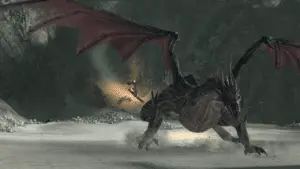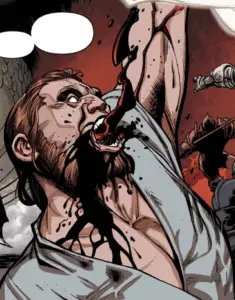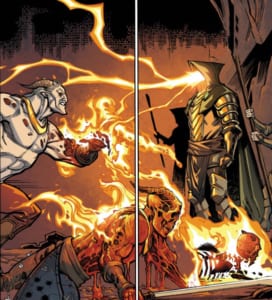Welcome to the fourth part in my Dragon Age lore dissection series. So far, I’ve talked about Darkspawn, dwarves, and Qunari. This time, I will discuss… dragons. Who are quite mysterious, considering that the series bears their name.
The Games
In the first game, there’s certainly not much to know about them. “Dragon Age” is a name from the Chantry calendar. The church named the century where the game takes place after dragons, as the beasts had begun appearing after being absent for a long time – until one went on rampage near the end of the Blessed Age. This prompted Divine Faustine II to give the next century a dragon’s name.
Still, in Origins they do not appear more than powerful, but nonetheless simple beasts. They’re highly territorial, and breed rapidly – but only very few reach the “high dragon” stage, where they take the size and shape we associate with dragons. They begin their life as dragonlings, deer-sized voracious reptiles. They then become drakes, which are larger, but still flightless. Male dragons never grow past that point, while female ones undergo a much larger growth until they become high dragons.
We meet one high dragon in Origins, who serves as an optional boss fight. During the quest for the Urn of the Sacred Ashes, the Warden meets a cult revering it as a reincarnation of Andraste. Even if the Warden cuts them all down, the dragon shows no signs of caring. It’s possible to take the ashes and leave without ever disturbing it, but you can also lure it in and defeat it. And what RPG player would turn down such an opportunity? Especially given how you need its scales for the best armor sets in the game.
In Awakening, the expansion to the first game, we fight another dragon… as a more or less random encounter. It’s just one thing in that expansion that’s pretty weird.
In Dragon Age 2, a high dragon likewise appears as an optional fight, to culminate the questline concerning a very unfortunate mine. The battle is… long. In a game full of damage sponges, the dragon is perhaps the worst. We don’t learn anything about dragons we didn’t already know.

Inquisition lets us fight ten different high dragons, each with a different sub-species name and sharing three different types of deadly breath. They’re challenging fights, as far as Inquisition goes, but still become fairly easy once you know which mechanics to lean on to win.
Those are not the only dragon fights in the series, though. We can also fight Flemeth, the Witch of the Wilds, who turns into a dragon to fight us. Then there’s the final boss of the Origins campaign, the Archdemon. The leader of the Darkspawn is supposedly an Old God of Tevinter, corrupted by the Blight. Later on, we find confirmation that it is, indeed, the case. And the fact that it takes the form of a dragon is undeniable either way.
This is where it gets interesting. The Old Gods of Tevinter being dragons is one the earliest hints that the beasts might be more than just a particularly large and deadly sort of territorial predator. But not the only one. From the very beginning, dragon blood is shown to have power. Drinking it lets warriors become reavers. There are dragon cults around regular dragons, not just Old Gods.
The Comics
Still, in order to get the juicy details, we need to dig into the tie-in comic books. One such juicy detail is the existence of great dragons, revealed in Silent Grove. It’s a stage of dragon growth beyond  the high dragon form. According to Yavana, they went into hiding after the Tevinter Imperium fell, and humans started to hunt them down. The Witches of the Wilds helped them hide, as “their blood is Thedas’ blood”, and they didn’t want humanity to destroy what it doesn’t understand. I suppose a couple thousand human peasants burnt to death is a small price when you’re a shape-changing witch.
the high dragon form. According to Yavana, they went into hiding after the Tevinter Imperium fell, and humans started to hunt them down. The Witches of the Wilds helped them hide, as “their blood is Thedas’ blood”, and they didn’t want humanity to destroy what it doesn’t understand. I suppose a couple thousand human peasants burnt to death is a small price when you’re a shape-changing witch.
Unfortunately, Yavana is a Witch of the Wilds – Flemeth’s daughter and Morrigan’s sister. True to family tradition, she’s hopelessly cryptic and treats straight answers like Anders treats Templars.
According to her, the legendary king Calenhad, the founder of Ferelden, found such a dragon, and another Witch of the Wilds. He made a deal to drink the dragon’s blood and gain tremendous power. It would make him a reaver, one supposes, but apparently a more powerful one than others. This version of the story is corroborated by Sten – or rather, the Arishok, at the time he appears in Those who Speak.
That’s not all Sten has to say on the general subject of dragons, however. As I mentioned in my Qunari article, the Tome of Koslun has something to say about the Old Gods:
“The Old Gods were unto dragons as the first human kings were unto ordinary men.”
That’s fairly direct. My first connection after reading those words were the Evanuris – supposedly the elven gods, in reality mage-rulers with earth-shattering power. Could the Old Gods have been similar figures to the dragons? But there’s one problem. Namely, the Evanuris weren’t human. They were elves.
I doubt that what Sten said is a complete lie, because why would it even be there? Those comics aren’t long, and wasting space on a red herring seems unlikely. There are a few possibilities, then. The first is that the “first human kings” does not refer to the Evanuris at all. Humans had their own god-kings. We don’t know anything about them otherwise, but then, we know extremely little about humanity’s origin in Thedas.
The second possibility is that while the Tome of Koslun speaks truth, it’s not entirely accurate. So it calls the Evanuris “humans”, even though they weren’t. We have a similar situation with the  Chant of Light, which does tell the truth, but also distorts it. It could even be that humans and elves were once the same people. Elves associate the loss of their immortality with the coming of humans. This is false, but could the humans be a result of the elves losing immortality?
Chant of Light, which does tell the truth, but also distorts it. It could even be that humans and elves were once the same people. Elves associate the loss of their immortality with the coming of humans. This is false, but could the humans be a result of the elves losing immortality?
This is all wild speculation on my part, so let’s move on to something more concrete. I do believe that the Old Gods were dragons’ god-kings, the most powerful of their kind. We know that dragons grow beyond the stage we encounter in the games. Or did, once. Maybe the Old Gods were the pinnacle of this growth.
This, of course, opens up a new set of questions. If the Old Gods are or were the oldest and most powerful of dragons, why were they asleep? According to Yavana, the great dragons hid after the fall of Tevinter. But the Old Gods spoke to the minds of Dreamers before Tevinter existed – in fact, they’re the ones who orchestrated its rise. When and why did they fall into slumber?
The most likely explanation appears to be that the creation of the Veil caused this. Aurelian Titus says that before the Veil, the dragons ruled the skies. He’s a Tevinter Magister who wants to use the blood of great dragons to power ancient Tevinter magic. To this end, he captures king Maric, and tries to get his hands on Alistair as well. Thus proving that Calenhad did drink dragon blood. Welcome to the “cultural hero/god/founding figure who’s actually awful” club, Calenhad. It might get a little crowded in here.
Titus’ plan is to tap into the power of the Dreamers. The Magisters could once enter the Fade, reshape it to their whims and control others through their dreams. He wants to control the minds of the entire world this way. To this end, he’s using a device from ancient Tevinter… but powering it up with dragon blood. Or what little of it remains in the last Theirins’s veins. He says that the old Magisters were “so close”, and all they needed was great dragons’ blood.
So, why didn’t they have it? If my theories are correct, they worshipped the dragons’ gods as their own. But perhaps the great dragons weren’t keen on parting with their blood, even so. And not even the Tevinter Imperium could match them… but then, how did the humans hunt them to near-extinction after Tevinter crumbled?
Regardless, it does show us that the dragons’ blood has power over the Fade. Blood magic does, in general – it can amplify any magical feat, in addition to its unique capabilities. And it can tear open the Veil. Using dragon blood seems to accomplish all that and more.
We also remember that lyrium is the Titans’ blood. So it just continues the theme of blood being power. Whether it’s human blood, elven blood, dragon blood or Titan blood.
The Old Gods contacted the Dreamers of the human tribes that would become Tevinter. So they had a presence in the Fade. Could it be their spirits were trapped there, after Solas broke the two worlds apart and created the Veil? If so, maybe the entire purpose of elevating Tevinter and teaching them blood magic was… to get out. Create a civilization that would produce mages powerful enough to tear open the Veil, and free them. But, as we know, it went horribly wrong.
Fitting it All Together
Another mention of dragons ruling the skies is found in a fairly unlikely place, in the games themselves. When we visit the Hissing Wastes, we find dwarven ruins. Those dwarves built a thaig on the surface, as their Paragon couldn’t bear his invention being used for war among other dwarves. A researcher’s journal we can find there indicates that the dwarves feared dragons a great deal. They warned one another to be wary of them if they should breach the surface and look at the sky.
As the journal’s author notes, that’s a lot of trepidation about a creature most dwarves would never see. Perhaps dragons were part of the reason dwarves stayed underground to begin with. But, as I’ve explained in my dwarven article, we know so very little about them.
What we’ve got here is a somewhat unclear chronology. It seems that the dragons were active, and dominated the skies, before Solas created the Veil and made Thedas what it is now. Do the writings in the Hissing Wastes predate the Veil, then? Or did dragons continue to be a threat after the worlds came apart?
What Yavana said about the great dragons would suggest that it was the case. But human civilizations grew on the surface despite the dragons. So there’s a bit of an incongruity here.
Another possibly related bit of knowledge is a torn notebook by an elven Qunari convert, found in the Deep Roads in Trespasser. They wonder why there are elven statues underground, and reminisces about how according to Dalish myth, the dwarves fear the sun because of Elgar’nan’s fire. They even theorize that it might be a metaphor for the Elvhen driving the dwarves underground. Could it be they used dragons to do it? Ancient elves do seem to have some connection to dragons. Or at least, Mythal does. Her mortal vessel, Flemeth, can take on a dragon’s form, and there’s still a dragon serving her.
In my last article, I brought up the likely connection between the Qunari and dragons. I don’t really have any insights now that I didn’t have back then. When Aurelian Titus uses the power of  dragonfire to incinerate some Qunari, he says “It could have been their birthright. Instead, it just kills.” Does he mean the Qunari, or the Theirin line? Considering who he’s melting alive at the time, I’m inclined to say the former, but I can’t be sure.
dragonfire to incinerate some Qunari, he says “It could have been their birthright. Instead, it just kills.” Does he mean the Qunari, or the Theirin line? Considering who he’s melting alive at the time, I’m inclined to say the former, but I can’t be sure.
I would like to point out something I decided to save for this one, however. The Scaled Ones. In Descent, we can encounter journals of a young dwarven soldier from before the First Blight. Turns out they had amazingly resilient paper back then. Or… what does an underground civilization make books out of?
Anyway, they went to fight some strange creatures who had been sighted in the tunnels. They describe “a man’s body like those of the Imperium humans, but covered in scales”. The “scaled ones” also had some sort of priest or mage, who could cast fire from their hand and mouth. They were draining dead dwarves of blood for an unknown purpose.
We also see a mosaic of a reptilian humanoid in the lost temple of Dirthamen. What does that mean? Heck if I know. But I feel like the Qunari weren’t the only attempt to emulate dragons.
As I discussed in more detail in my Darkspawn article, the Old Gods now become Archdemons and lead Blights. I suppose I have reached a point where all the threads of lore intersect. And like I said back then, we don’t know just why the Darkspawn seek out the Old Gods. They follow their song in the dark, and reach out for perfection they can never have. Is it simply a twisted echo of the desire the Magisters Sidereal felt when they assaulted the heavens? Or something more?
And, of course, Morrigan used an Archdemon to continue the same mission Yavana and other Witches undertook. Save the remnants of the ancient world, including the dragons. Thus, she tries to arrange for the soul of Urthemiel to enter her unborn child, instead of possessing a Grey Warden and annihilating them both.
We know even less about dragons than about other parts of the lore, but some things become apparent. The Old Gods join the roster of ancients, alongside the Evanuris and Titans. Other gods who turned out to be something less. Or just different. Is a god less of a god because it wasn’t always this way? The dragons may have entered the franchise as challenging boss fights with good loot, but they’re clearly intimately tied to Thedas itself.

